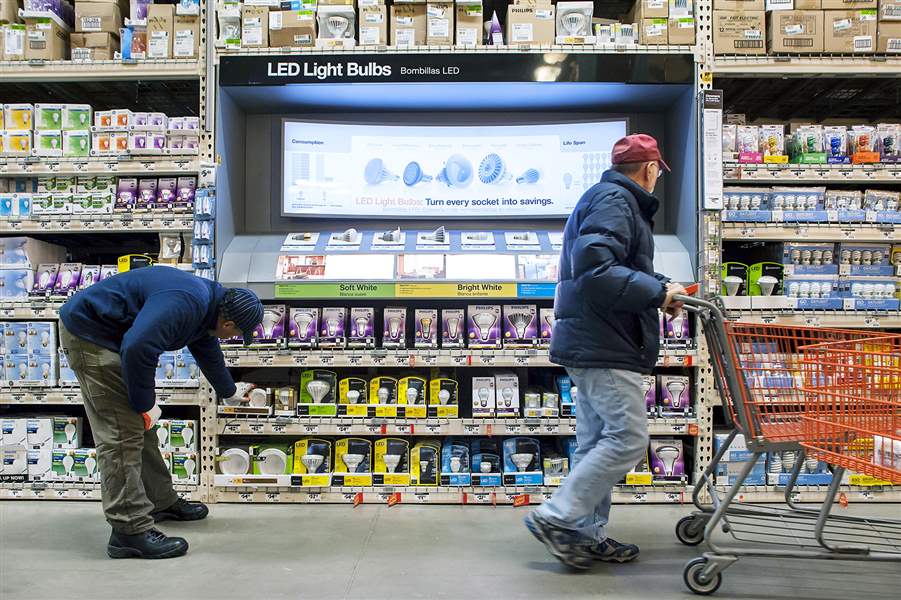
U.S. STANDARDS SHED LIGHT ON NEW BULBS
New year ushers in change from century-old technology
12/30/2013
The light bulb aisle at a Home Depot in Vauxhall, N.J., features a display about LED bulbs. Consumers won’t see old-style 40-watt and 60-watt bulbs anymore when shopping, starting on Wednesday.
NEW YORK TIMES
Here’s some guidance:
■ Read the Lighting Facts label.
It appears on every package of light bulbs and looks much like the Nutrition Facts label on food. It provides basic information, including how bright the bulb is, how much power it uses, how much you can expect to pay for that electricity, and how warm or cool the light appears. That information makes it easier to compare bulbs.
■ Know the lingo.
Understanding the label is easier if you know a couple of terms, noted Celia Lehrman, deputy content editor for home and appliances with Consumer Reports, which recently released its latest light bulb ratings.
One of those terms is “lumens,” which measure a bulb’s brightness. You should buy a bulb of about 450 lumens to replace an old-style 40-watt bulb, 800 lumens to replace a 60-watt bulb, 1,100 lumens to replace a 75-watt bulb, and 1,600 lumens to replace a 100-watt bulb.
The other is “Kelvin,” the scale used to measure color temperature — in other words, how warm or cool the light appears. If you like the warm light from an old-style incandescent bulb, look for a color temperature of 2,700 Kelvin, Ms. Lehrman said. The higher the Kelvin number, the cooler and whiter the light will be.
■ Look for the Energy Star logo.
If you’re shopping for a CFL or LED bulb, Ms. Lehrman recommendeds choosing one with an Energy Star label. For those types of bulbs, the label indicates more than just energy savings. It also indicates the bulb meets certain quality standards, such as coming on instantly or nearly so, staying bright over its lifetime, and producing an excellent color of light. What’s more, all Energy Star bulbs must be backed by warranties.
■ Look elsewhere on the package.
Light bulb packages can tell you a lot about how a bulb is best used. While halogen bulbs can be used in the same ways as old-style incandescent bulbs, LEDs and CFLs behave differently in some applications. The package will tell you such information as whether the bulb is dimmable, whether it’s made for outdoor use, and whether it can be used in an enclosed fixture.
■ Check rebates.
Sometimes governments or utilities offer rebates on energy-efficient lighting. You can check for rebates at www.dsireusa.org or www.energystar.gov (type “rebates” into the search box to find the page labeled “Special Offers and Rebates From Energy Star Partners”).
Say good-bye to the old-style light bulb.
Starting Wednesday, the last of the federal government’s new lighting standards take effect. That means the sort of general-service light bulb we’ve used for more than a century can no longer be made in or imported into the United States.
What does that mean for you?
On the plus side, it means more choices and smaller electric bills. On the minus side, it means an end to dirt-cheap light bulbs and grab-and-go bulb shopping. Now you need to read labels.
The new lighting standards, part of the Energy Independence and Security Act of 2007, were intended to make light bulbs more efficient and reduce the amount of energy needed to power them. They’ve done that, but they’ve also left some consumers confused in the face of all the choices in the lighting aisle.
“You’re used to buying that 60-watt bulb and knowing what it looks like and everything else,” said Cordell Blackmon, manager of the Batteries + Bulbs store in Copley Township, Ohio. Now, he said, customers who buy bulbs in haste often bring them back when they find the bulbs don’t meet their expectations.
Buying the right bulb requires more attention than it used to, Mr. Blackmon said.
But with a little education and guidance, he said, his customers end up with what they need.
The Wednesday phaseout of old-style 40-watt and 60-watt bulbs is the third step in the change to more efficient forms of lighting. The first step, in 2012, targeted 100-watt bulbs and was followed last year by the elimination of traditional 75-watt bulbs.
Although the lighting law has commonly been called a ban on incandescent light bulbs, lighting experts say that’s inaccurate. The law doesn’t ban incandescent bulbs, but only requires them to be more energy-efficient.
What’s more, the law doesn’t affect all incandescent light bulbs, just general-service bulbs — pear-shaped bulbs with a medium base, the kind that for years were used most commonly in the home. A lot of bulbs are exempt, including three-way bulbs, 150-watt bulbs, and bulbs with narrower candelabra bases that are often used in chandeliers.
The law may frustrate some consumers, but many lighting specialists and sustainability advocates cheer the innovations it has spurred.
The government lighting standards “have led to more lighting innovation over the past five years than we saw during the 100-plus years since Edison invented the light bulb,” Noah Horowitz, director of the National Resources Defense Council’s Center for Energy Efficiency, wrote in his blog.
Now consumers have essentially three choices: compact fluorescent light bulbs, LED bulbs, and halogen bulbs.
Compact fluorescent light bulbs, or CFLs, are long-lasting and stingy on energy use and relatively inexpensive. But they have features some people don’t like, including the inclusion of a tiny amount of mercury.
LED bulbs are illuminated by light-emitting diodes. They last for decades and use even less energy than CFLs, but they’re still fairly expensive.
Halogen bulbs are the most like the old familiar incandescent bulbs. They don’t save nearly as much electricity or last as long as the others, but they’re probably the best choice for people who really don’t want to change, said Terry McGowan, director of engineering for the American Lighting Association.